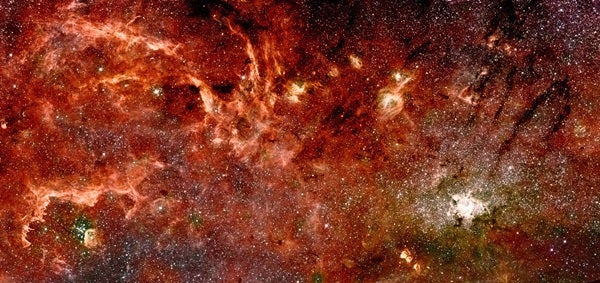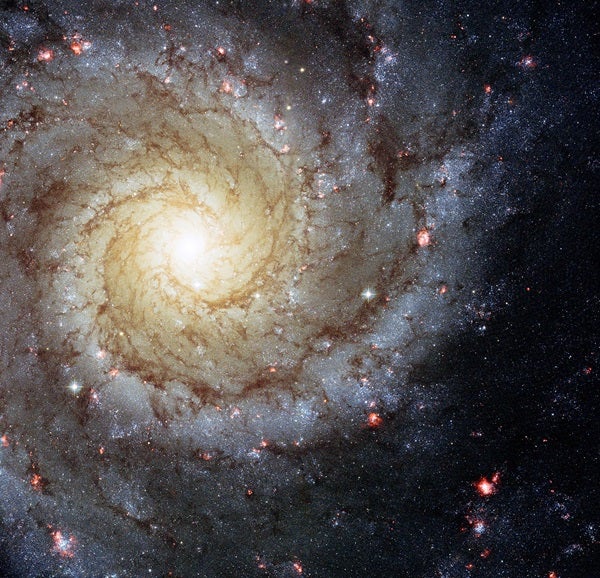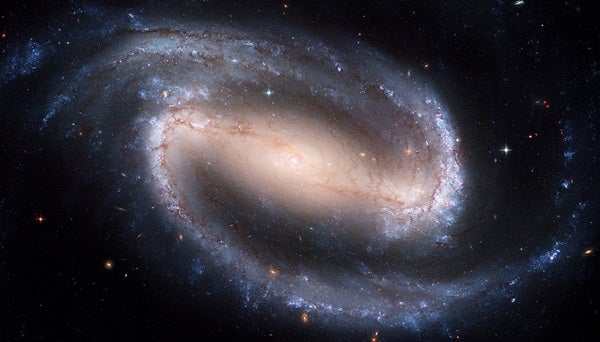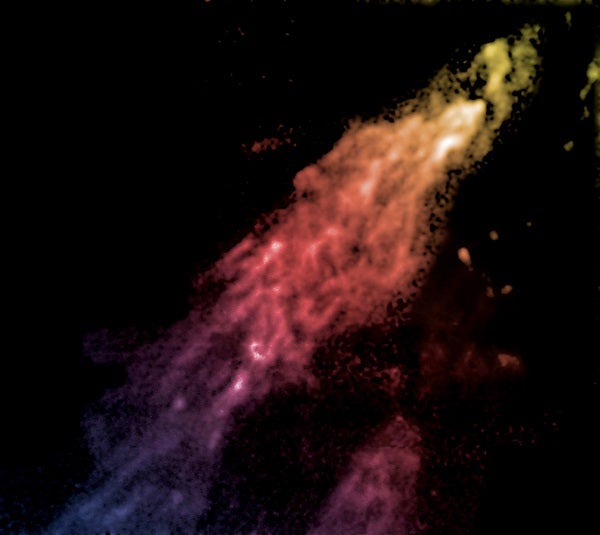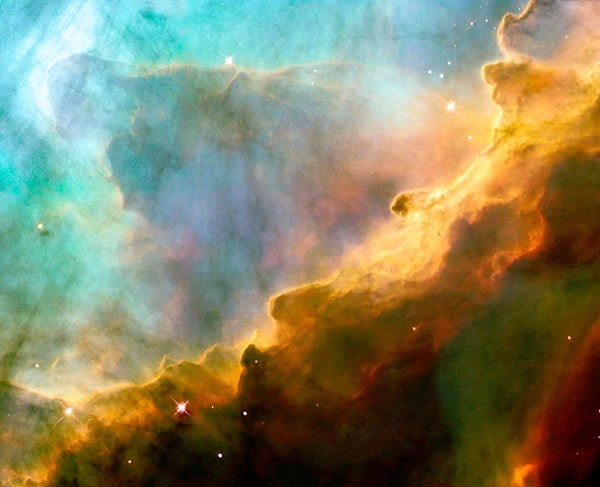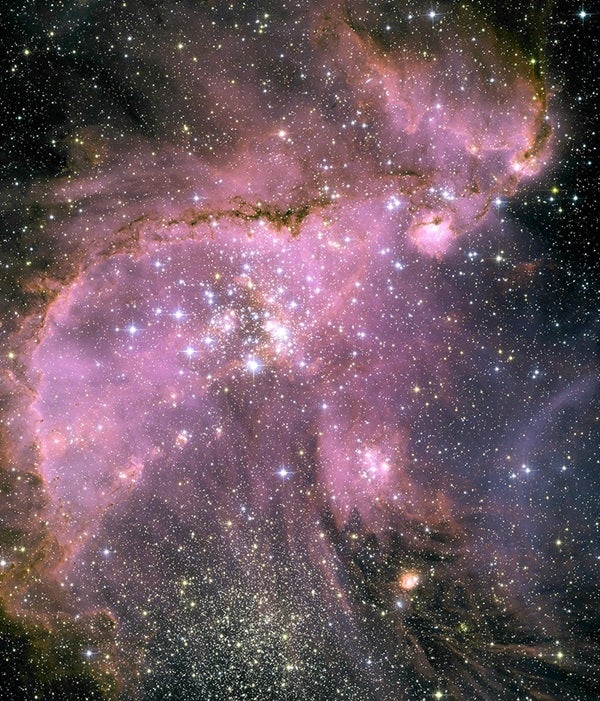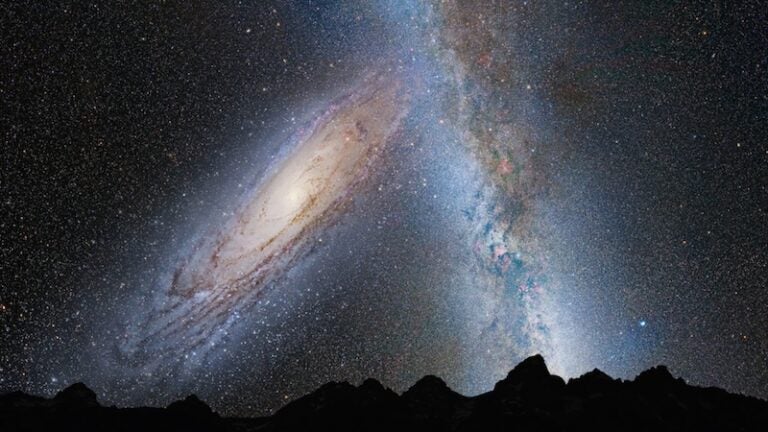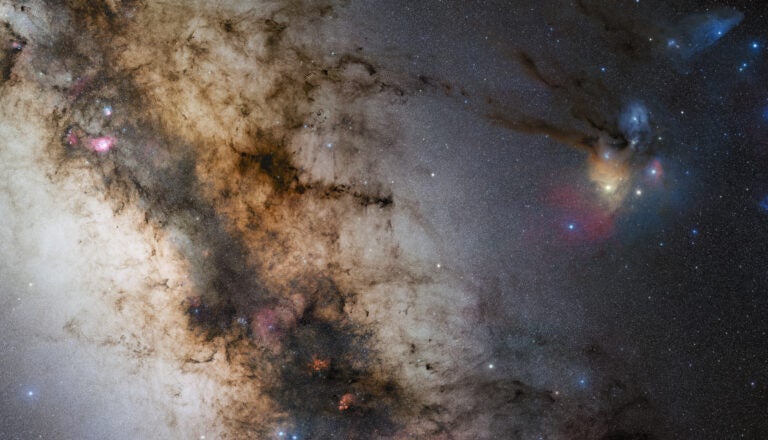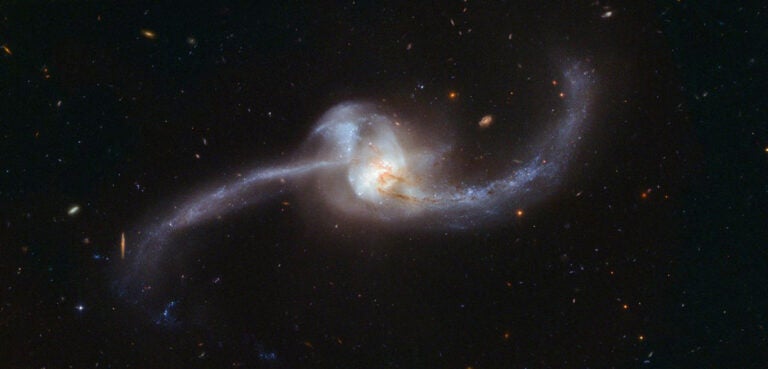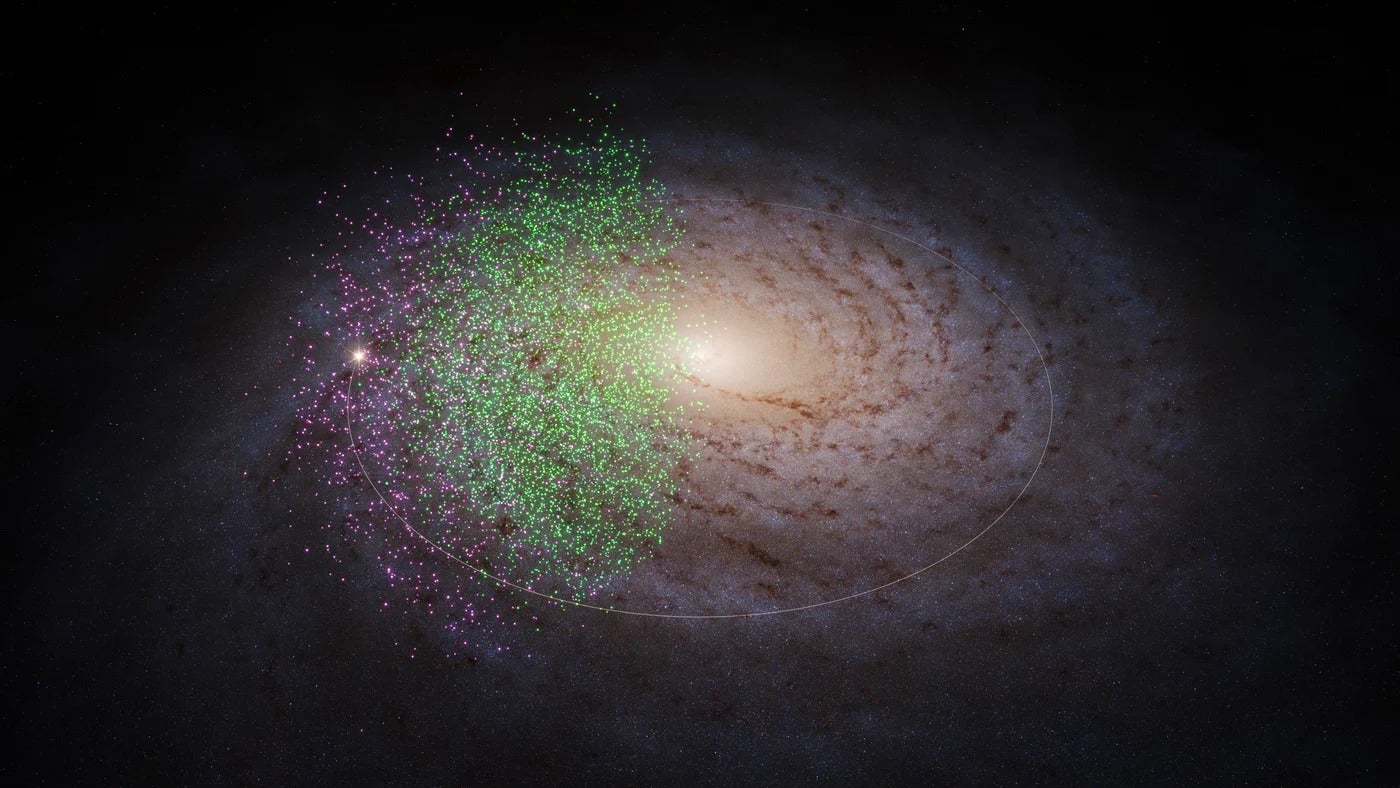If you sit down with a photo album of galaxies, it doesn’t take long to see that they are like snowflakes: No two are alike, and they are hard to study at a distance.
Happily, we have a close-up view of one galaxy — our own Milky Way. We can see its individual stars and determine their motions, map its interstellar gas and dust, and make all sorts of measurements that observers of other galaxies could only dream about.
But there is one major drawback. We are stuck in the middle of the galaxy’s dusty disk, so it has been difficult to determine what the Milky Way looks like from the outside.
Thanks to decades of research and major advances in telescope technology, some of the Milky Way Galaxy’s basic characteristics are now clear. We have a provisional map of its spiral arms, evidence for a pronounced galactic bar, and observations of a dense, gaseous star-forming region surrounding a supermassive black hole. But how do these pieces fit together? How does the Milky Way’s star-making machine work?
What does the Milky Way do?
Typically, astronomers think of our galaxy as a stellar island, a collection of 200 billion or more stars orbiting a common center of mass. But stars make up only 10 percent of the Milky Way’s total mass. About 1 percent consists of gas and dust drifting between the stars — the so-called interstellar medium. The rest appears to be dark matter. This mysterious substance — unlike visible, or “baryonic,” matter — betrays its presence only by its gravitational pull on its surroundings.
The galaxy’s relatively small reservoir of interstellar gas may not sound like much at a mere 1 percent of the total. However, it represents enormous potential for star birth. The galaxy’s gas could make enough stars to equal about 1 billion times the Sun’s mass.
Gas is central to the galaxy’s inner workings. A star is a self-gravitating ball of gas whose “job” is to fuse hydrogen. This, in turn, releases energy and makes heavier elements. Similarly, think of a galaxy as a self-gravitating assembly of dark matter, stars, and gas whose function is to convert gas into new suns.
A few key factors regulate the location and rate of star formation in spiral galaxies. Influential work in 1989 by Rob Kennicutt, now at the University of Cambridge, proved that the star formation rate in spiral galaxies is related to the density of gas in the galactic disk. This relation is called the Kennicutt-Schmidt Law because it builds on an earlier idea proposed by Dutch astronomer Maarten Schmidt.
In their efforts to understand how the Milky Way and other galaxies work, astronomers must deal with some complications. One is that galaxies do not evolve in isolation after they form. They interact with their environments, and this shapes their fates.
For example, astronomers using the massive Sloan Digital Sky Survey have discovered several new nearby “dwarf” galaxies surrounding the Milky Way. These faint stellar structures, all much closer to us than the Andromeda Galaxy, frequently appear stretched across the sky. This indicates their disruption by the Milky Way’s powerful gravitational field. Our galaxy has already absorbed the remains of many dwarfs.
Intergalactic clouds, typically containing a few million solar masses of hydrogen, also interact with and become part of our galaxy. Just to cite one notable example, a vast mass of hydrogen, Smith’s Cloud, orbits the Milky Way. It contains enough gas to build an entire dwarf galaxy. The evidence suggests Smith’s Cloud will eventually merge with the Milky Way, depositing raw material for future star creation. Astronomers have located at least two dozen large clouds and hundreds of smaller ones orbiting the galaxy.
Much of the gas brought in by intergalactic clouds serves to refuel the galaxy’s star formation engine. But collisions between the Milky Way and dwarf galaxies or gas clouds can trigger bursts of star formation on their own. When the mass and frequency of this constant intergalactic bombardment is high enough — and presumably this would change over time — it could affect or even determine how the galaxy evolves.
Galactic laws
Any engine, particularly one as complex as our galaxy, has many moving parts. Here are the fundamental physical principles and processes that help drive the whole system.
The galaxy is trying to collapse to a central point.
The Milky Way Galaxy is a self-gravitating system. All self-gravitating systems have a tendency to collapse in on themselves. And they would if it weren’t for other forces counteracting or slowing the collapse.
In galaxies, one of the forces that opposes gravity is star formation. As gas clouds collapse within the Milky Way’s disk, some of them grow dense enough to ignite into new stars. The galaxy’s rotation also puts up a fight. In the outward (radial) direction, the Milky Way resists gravitational collapse by rotating. (Its extended spherical halo of stars also appears to rotate, but much more slowly.) Absent these forces, the galaxy would contract until its gravity warped space-time inward to form a black hole.
One place where this ultimate act of gravitational collapse has occurred is at the Milky Way’s center, home to Sagittarius A* (pronounced “A star”). It’s a giant black hole containing about 4 million solar masses. The process by which the Milky Way and other galaxies form such “supermassive” black holes is still poorly understood. Fortunately, only a paltry amount of the galaxy’s total bulk ended up in the central black hole.
Galactic evolution increases the total disorder of the universe.
In physics, the term entropy describes the amount of randomness or disorder in a self-contained (“closed”) system. Frank Shu of the University of California, San Diego, has emphasized in his writing that a fundamental tension in astrophysics is the battle between gravity, the great organizer, and the second law of thermodynamics, the great disorganizer. The second law states that physical systems tend to move irreversibly toward a state of disorder, or increased entropy.
Nature always seems to find a way to slow or prevent self-gravitating systems from collapsing to a state of infinite density. Stars, for example, generate photons via nuclear fusion. The resulting release of heat and radiation pressure holds up a star against gravity. The outward flow of photons into space adds to the overall entropy of the universe.
A galaxy’s interstellar gas also engages in a battle with gravity. In the direction perpendicular to the galactic plane, the gas in a disk-shaped galaxy supports itself against gravity by forming stars. Since the gas is diluted, radiation from the stars provides very little push on it. Most of the interstellar pressure comes from turbulent gas motions, cosmic rays, and magnetic fields generated by the energy input from the stars.
A galaxy’s angular momentum must always be conserved.
Angular momentum is the tendency of a rotating mass to continue doing so unless some outside force intervenes. In other words, because the Milky Way’s disk was born spinning, it continues to spin. The galaxy’s total angular momentum cannot change without some inflow or outflow of material from outside the system.
Much of the stellar mass of the Milky Way lies within a thin disk, which lies within a lower-density thick disk and the extended, diffuse stellar halo. Within the galaxy, the only way stars or gas can change position is by redistribution of angular momentum. For example, a cloud of interstellar gas can move toward the galaxy’s center only by shedding some angular momentum.
The Milky Way and other spiral galaxies have two prominent features that allow gas to lose angular momentum and migrate toward the center: bars and spiral arms. More than 60 percent of galaxies may have bars.
It is not clear what triggers a galaxy to form a bar. For some reason, stars in the galaxy’s interior interact with each other so that their circular orbits become more stretched out, or elliptical. These stars then perturb other stars, which further reinforces the bar structure. The Milky Way has a prominent galactic bar approximately 28,000 light-years long, but there is still debate as to its vertical thickness along that length.
The bar’s gravitational field diverts interstellar gas from its normally circular motion around the galaxy. The gas streams collide with each other, triggering large-scale compression and heating. In fact, the presence of compressed, or “shocked,” gas toward the galactic center tipped off astronomers to the likely presence of a galactic bar even before they could actually see it.
In 1957, Dutch astronomer Hugo van Woerden discovered a structure called the Three-Kiloparsec Arm. Located in the galaxy’s dense central region, the structure consists of shocked gas. Astronomers hypothesized that a central bar was causing the gas to pile up
In 2008, Thomas Dame and Patrick Thaddeus of the Harvard-Smithsonian Center for Astrophysics discovered a remarkably similar counterpart to the Three-Kiloparsec structure, presumably located parallel to the bar on the far side of the galactic center. We now call these features the Near and Far Three-Kiloparsec arms.
In the center of the Milky Way’s bar lies the Central Molecular Zone. The entire area is about 2,400 light-years across. The bar helps funnel gas into this star-forming zone of highly shocked gas. Outside the central bar, the Milky Way’s spiral arms also help move gas inward. The details of how spiral arms form and propagate are still unsettled despite decades of research, but their basic features are now fairly clear.
The spiral arms are zones within the galactic disk where the density of stars is higher. The zones don’t rotate along with the disk. Instead, stars and gas pass through the zones as they orbit the galactic center. The situation resembles the effect of a traffic snarl on the highway: As stars and gas clouds hit the region of high density, they begin to slow down and bunch up. As the stars and gas exit the snarl, they spread out and resume normal speed.
During the slowdown, gas passing through the arms has a tendency to deflect slightly inward. The net effect is for gas to flow toward the galactic center. This feeds the most active star-forming regions.
Galaxies try to remain symmetrical, but usually fail.
The rotating disks of galaxies should be symmetric around the rotation axis, like a spinning DVD. But the best many can do is remain bisymmetrical, meaning they tend to look the same on opposite sides.
Bisymmetry means that astronomers expect structures in the Milky Way to come in pairs. The existence of twin Three-Kiloparsec arms certainly meets this expectation. The same rule may also apply to the spiral arms outside the bar. A survey with the Spitzer Space Telescope suggests two of the spiral arms (Norma and Sagittarius) may represent bunching up of the interstellar gas alone. The other two spiral arms (Scutum-Centaurus and Perseus) appear to contain both interstellar gas and stars and connect to the ends of the central galactic bar
The galaxy’s outer regions seem more prone to deviate from bisymmetry. Looking toward the outer edges of the galaxy with our backs to the galactic center, gas does not rotate exclusively from right to left. Part of the gas motion is toward or away from us. This could be evidence that the galaxy’s overall shape is somewhat oval rather than perfectly round, as proposed by Leo Blitz of the University of California, Berkeley, and David Spergel of Princeton University.
The Milky Way is imperfectly shaped in other ways. The gas layer in the galactic disk has a flare — it gets thicker with distance from the center. The disk is also warped, forming a shape similar to a potato chip. The cause of these irregularities could be the effect of gravitational interactions with neighboring dwarf galaxies, infalling intergalactic gas, or the galaxy’s dark matter halo.
The galaxy in a nutshell
Simply put, the Milky Way is a gravitating system that converts gas into stars. It attempts to funnel gas toward the galactic center. However, the collapse of gas into stars and the difficulty in getting rid of the angular momentum of the gas hampers the flow. The Milky Way’s bar and spiral arms help speed the inward movement of gas. Overlaid on these processes are disruptive outside influences, such as collisions with other galaxies and infalling clouds of gas.
Right now, the various observations and insights astronomers have gathered about the Milky Way lie unassembled, like pieces of a jigsaw puzzle. In the 20th century, astronomers knitted many different insights on stars into a physical theory for star formation and evolution. Perhaps next scientists will assemble a unifying theory for understanding galaxies — particularly our own Milky Way.

